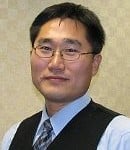 Michigan Technological University and REL, Inc., a Calumet-based technology company with a focus on material-process development, have been awarded a $2.1-million, three-year investment from Southwestern Energy Company (SWN) of Houston, Texas.
Michigan Technological University and REL, Inc., a Calumet-based technology company with a focus on material-process development, have been awarded a $2.1-million, three-year investment from Southwestern Energy Company (SWN) of Houston, Texas.
Read More
 The ME-EM Graduate Seminar speaker on Thursday, December 11 at 4:00 in 103 EERC will be Karen Krueger, Postdoctoral Fellow from Orthopaedics Department, University of Iowa.
The ME-EM Graduate Seminar speaker on Thursday, December 11 at 4:00 in 103 EERC will be Karen Krueger, Postdoctoral Fellow from Orthopaedics Department, University of Iowa.
The title of her presentation will be ‘Computational and Experimental Biomechanics of Total Hip Wear Increase Due to Femoral Head Damage’.
Aseptic loosening due to wear-induced osteolysis remains a leading cause of failure in total hip arthroplasty (THA), par-ticularly in revisions required beyond the second decade of use. Historically, there have been large amounts of variability of wear within individual THA patient cohorts. Evidence indicates that femoral head damage can be a cause of this varia-bility. While femoral head damage as a result of third body particles and subluxation and dislocation events has been well documented, direct quantifiable linkage between such femoral head damage and wear acceleration remains to be estab-lished. Due to large ranges of observed retrieval damage, wear testing protocols for simulating third body and other dam-age effects have been widely variant, making it difficult to know where the clinical reality lies.
To study the effect of retrieval femoral head damage on total hip implant wear, a damage-feature-based finite element (FE) formulation was developed, which allowed for wear prediction due to individual scratch, scrape, and transfer deposit features. A multi-scale imaging procedure was also developed to globally map and quantify micron-level damage features appearing on retrieval femoral heads. This allowed for wear simulations of damage patterns observed on specific retrieval femoral heads. Retrieval damage was shown to be highly variable among patients, and capable of producing up to order-of-magnitude wear increases when compared to undamaged heads. Damage following dislocation and subsequent closed reduction maneuvers was found to be particularly detrimental, with average wear rate increases in the range of half an or-der of magnitude. These data were used to develop wear testing protocols for simulating clinically-occurring third body and other damage effects.
Karen Kruger is currently a postdoctoral fellow in the Orthopaedics depart-ment at the University of Iowa. She earned her B.S. in mechanical engineering and biomedical engineering from Michigan Technological University while com-peting in Varsity cross country and Nordic skiing. While at Michigan Tech, she received a Michigan Space Grant to study the effectsof spaceflight on the knee joint meniscus. She went on to complete her Ph.D. in Biomedical Engineering with a focus on orthopaedic biomechanics at the University of Iowa under the direction of Dr. Thomas Brown. Her dissertation work focused on wear in total hip replacements.
 The mechanical engineering-engineering mechanics department held its semi-annual Senior Capstone Design Day Program. Eight teams presented the fruits of their efforts over the past two semesters during presentations to industry reps, faculty, staff, and students. The teams also displayed posters and, in some cases, their prototypes in the rear first-floor hallway of the MEEM building.
The mechanical engineering-engineering mechanics department held its semi-annual Senior Capstone Design Day Program. Eight teams presented the fruits of their efforts over the past two semesters during presentations to industry reps, faculty, staff, and students. The teams also displayed posters and, in some cases, their prototypes in the rear first-floor hallway of the MEEM building.
Keynote Speaker: Gerald E. McGlynn III, 1984 B.S. in Mechanical Engineering, Michigan Tech, Intellectual Property Attorney, Howard and Howard; J.D., cum laude, from Detroit College of Law in 1988
 If seeing is believing, C.K. Choi (Adjunct Assistant Professor, Biomedical Engineering and Assistant Professor, Mechanical Engineering–Engineering Mechanics) has a passion for clarity—in a very tiny world. The assistant professor of mechanical engineering’s research lies at the micro-scale, in channels no thicker than a strand of hair.
If seeing is believing, C.K. Choi (Adjunct Assistant Professor, Biomedical Engineering and Assistant Professor, Mechanical Engineering–Engineering Mechanics) has a passion for clarity—in a very tiny world. The assistant professor of mechanical engineering’s research lies at the micro-scale, in channels no thicker than a strand of hair.
Read more —
 The ME-EM Graduate Seminar speaker on Thursday, December 4th at 4:00 in 103 EERC will be Dr. Renu Sharma from National Institute of Standards and Technology, Center for Nanoscale Science and Technology.
The ME-EM Graduate Seminar speaker on Thursday, December 4th at 4:00 in 103 EERC will be Dr. Renu Sharma from National Institute of Standards and Technology, Center for Nanoscale Science and Technology.
The title of her presentation will be ‘Correlative microscopy for in situ characterization of catalyst nanoparticles under reactive environments’.
In recent years the environmental transmission scanning electron microscope (ESTEM) has been success-fully employed to elucidate the structural and chemical changes occurring in the catalyst nanoparticles un-der reactive environments. While atomic-resolution images and the combination of high spatial and energy resolution is ideally suited to distinguish between active and inactive catalyst particles and identify active surfaces for gas adsorption, unambiguous data can only obtained from the area under observation. This lack of statistical information available from TEM measurements is generally compensated for by using other, ensemble measurement techniques such as x-ray or neutron diffraction, x-ray photoelectron spec-troscopy, infrared spectroscopy, Raman spectroscopy etc. However, it is almost impossible to create iden-tical experimental conditions in two separate instruments to make measurements that can be directly com-pared. Moreover, ambiguities in ESTEM studies may arise from the unknown effects of the incident elec-tron beam and uncertainty of the sample temperature. We have designed and built a unique platform that allows us to concurrently measure atomic-scale and micro-scale changes occurring in samples subjected to identical reactive environmental conditions by incorporating a Raman Spectrometer on the ESTEM. We have used this correlative microscopy platform i) to measure the temperature from 60 μm2 area using Ra-man shifts, ii) to investigate light/matter interactions iii) as a heating source, iii) for concurrent optical and electron spectroscopy such as cathodoluminescence, EELS and Raman. Details of the design, function, and capabilities will be illustrated with results obtained from in situ combinatorial measurements.
Renu Sharma is a Project Leader in the Nanofabrication Research Group. She received a B.S. and B.Ed. in Physics and Chemistry from Panjab University, India, and M.S. and Ph.D. degrees in Sol-id State Chemistry from the University of Stockholm, Sweden, where she had a Swedish Institute Fellowship. Renu joined the CNST in 2009, coming from Arizona State University (ASU), where she began as a Faculty Research Associate in the Department of Chemistry and Biochemistry and the Center for Solid State Science, and most recently served as a Senior Research Scientist in the LeRoy Eyring Center for Solid State Science and as an affiliated faculty member in the School of Materials and Department of Chemical Engineering. Renu has been a pioneer in the development of environmental scanning transmission electron microscopy (E(S)TEM), combining atomic-scale dynamic imaging with chemical analysis to probe gas-solid reactions. She has applied this powerful technique to characterize the atomic-scale mechanisms underlying the synthesis and reactivity of nanoparticles (including catalysts), nanotubes, nanowires, inorganic solids, ceramics, semiconductors, and superconductor materials. Renu has received a Deutscher Akademischer Austauschdienst (DAAD) Faculty Research Fellowship, is a past President of the Arizona Im-aging and Microanalysis Society, and has given over 70 invited presentations, and published 3 book chapters and over 160 research articles. At the CNST, Renu is establishing advanced E(S)TEM measurement capabilities for nanoscience re-search and contributing her research expertise to the operation of a new TEM facility in the NanoFab.